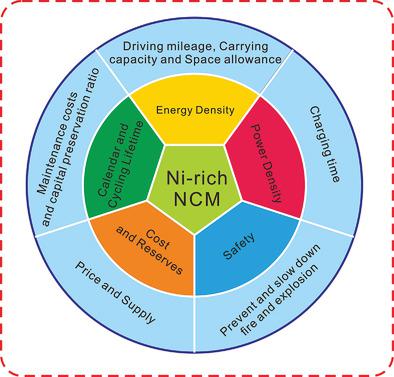当前位置:
X-MOL 学术
›
Adv. Energy Mater.
›
论文详情
Our official English website, www.x-mol.net, welcomes your
feedback! (Note: you will need to create a separate account there.)
Ni‐Rich/Co‐Poor Layered Cathode for Automotive Li‐Ion Batteries: Promises and Challenges
Advanced Energy Materials ( IF 24.4 ) Pub Date : 2020-02-14 , DOI: 10.1002/aenm.201903864 Xinxin Wang 1 , Yuan‐Li Ding 1, 2 , Ya‐Ping Deng 3 , Zhongwei Chen 3
Advanced Energy Materials ( IF 24.4 ) Pub Date : 2020-02-14 , DOI: 10.1002/aenm.201903864 Xinxin Wang 1 , Yuan‐Li Ding 1, 2 , Ya‐Ping Deng 3 , Zhongwei Chen 3
Affiliation

|
To pursue a higher energy density (>300 Wh kg−1 at the cell level) and a lower cost (<$125 kWh−1 expected at 2022) of Li‐ion batteries for making electric vehicles (EVs) long range and cost‐competitive with internal combustion engine vehicles, developing Ni‐rich/Co‐poor layered cathode (LiNi1−x−yCoxMnyO2, x+y ≤ 0.2) is currently one of the most promising strategies because high Ni content is beneficial to high capacity (>200 mAh g−1) while low Co content is favorable to minimize battery cost. Unfortunately, Ni‐rich cathodes suffer from limited structure stability and electrode/electrolyte interface stability in the charged state, leading to electrode degradation and poor cycling performance. To address these problems, various strategies have been employed such as doping, structural optimization design (e.g., core–shell structure, concentration‐gradient structure, etc.), and surface coating. In this review, five key aspects of Ni‐rich/Co‐poor layered cathode materials are explored: energy density, fast charge capability, service life including cycling life and calendar life, cost and element resources, and safety. This enables a comprehensive analysis of current research advances and challenges from the perspective of both academy and industry to help facilitate practical applications for EVs in the future.
中文翻译:

用于汽车锂离子电池的富镍/贫电分层阴极:承诺和挑战
追求更高的能量密度(在电池单元级别> 300 Wh kg -1)和更低的成本(到2022年预计低于$ 125 kWh -1),以使电动汽车(EV)的续航里程长且具有成本竞争力与内燃机车辆,开发富Ni / Co的贫层状阴极(的LiNi 1- X - ý钴X锰Ý ø 2,X + ÿ ≤0.2)是目前最有希望的策略之一,因为高Ni含量是有益的至高容量(> 200 mAh g -1),而低的Co含量有利于最大程度地降低电池成本。不幸的是,富镍阴极在充电状态下具有有限的结构稳定性和电极/电解质界面稳定性,从而导致电极退化和较差的循环性能。为了解决这些问题,已采用了各种策略,例如掺杂,结构优化设计(例如,核-壳结构,浓度-梯度结构等)和表面涂层。在这篇综述中,探讨了富镍/贫钴层状阴极材料的五个关键方面:能量密度,快速充电能力,使用寿命(包括循环寿命和日历寿命),成本和元素资源以及安全性。
更新日期:2020-03-27
中文翻译:

用于汽车锂离子电池的富镍/贫电分层阴极:承诺和挑战
追求更高的能量密度(在电池单元级别> 300 Wh kg -1)和更低的成本(到2022年预计低于$ 125 kWh -1),以使电动汽车(EV)的续航里程长且具有成本竞争力与内燃机车辆,开发富Ni / Co的贫层状阴极(的LiNi 1- X - ý钴X锰Ý ø 2,X + ÿ ≤0.2)是目前最有希望的策略之一,因为高Ni含量是有益的至高容量(> 200 mAh g -1),而低的Co含量有利于最大程度地降低电池成本。不幸的是,富镍阴极在充电状态下具有有限的结构稳定性和电极/电解质界面稳定性,从而导致电极退化和较差的循环性能。为了解决这些问题,已采用了各种策略,例如掺杂,结构优化设计(例如,核-壳结构,浓度-梯度结构等)和表面涂层。在这篇综述中,探讨了富镍/贫钴层状阴极材料的五个关键方面:能量密度,快速充电能力,使用寿命(包括循环寿命和日历寿命),成本和元素资源以及安全性。











































 京公网安备 11010802027423号
京公网安备 11010802027423号